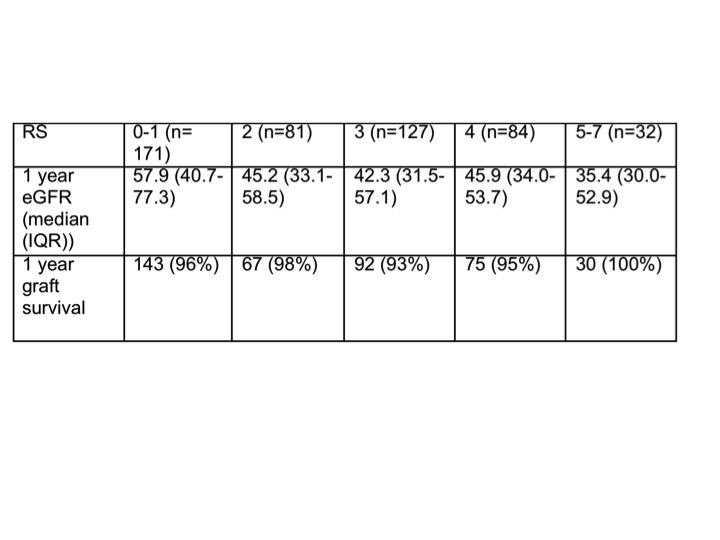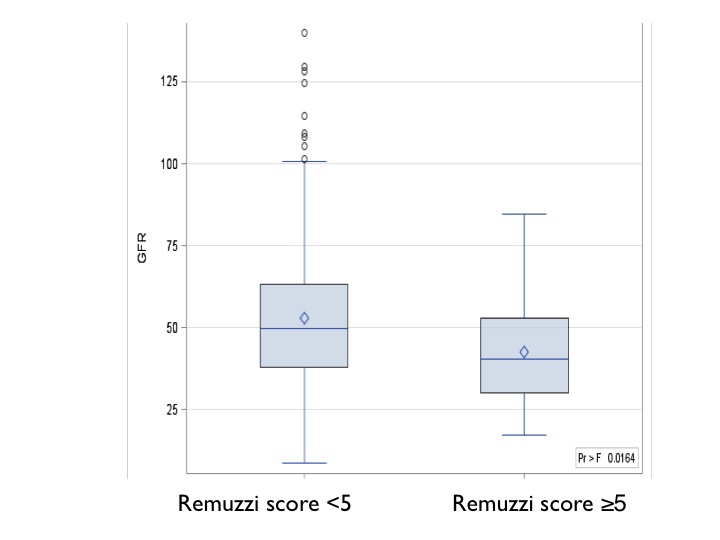Pre-Transplant Histological Assessment Provides a Useful Predictor of Subsequent Kidney Allograft Function
Adam Brayne1, Patrick Trotter2, Daniel Hart1, Gavin Pettigrew2, Menna Clatworthy1.
1Department of medicine, University of Cambridge, Cambridge, United Kingdom; 2Department of surgery, University of Cambridge, Cambridge, United Kingdom
Introduction: Organ shortage is a major challenge in transplantation. In view of this problem, organs from marginal donors are increasingly being considered for transplantation. In kidney transplantation, histological assessment of deceased donor kidneys with the Remuzzi score (RS) has proven to be effective at predicting renal allograft survival but requires further validation. Addenbrookes Hospital in Cambridge, UK, has used RSs to determine suitability of deceased donor kidneys from older donors and those with multiple co-morbidities, for single or dual transplantation. From 2010, kidneys with a RS of 1-3 were deemed suitable for single kidney transplantation, and in 2014 this was extended to include kidneys with a RS of 4. We sought to assess the efficacy of the RS to predict kidney transplant outcomes and to confirm that single kidneys transplanted with RS of 4 had reasonable outcomes.
Methods: All recipients of single deceased donor kidney transplants performed at Addenbrookes hospital, Cambridge, with available pre-transplant RSs, between 2010 and 2016 were identified. Transplant outcomes (death censored graft survival and 1 year eGFR) were analysed.
Results: In total, 495 single deceased donor kidneys with RSs were identified. Of these 40.2% were from donation after brain stem death donors (DBD), and 59.8% were from donation after circulatory death donors (DCD). The breakdown of the RS of these kidneys are shown in figure 1.
The 1 year eGFR and graft survivals according to their RS are shown in Table 1. 
1 year death censored graft survival was not negatively impacted by higher pre-donation RS (p=0.54). However, graft function at 1 year was significantly worse with a RS ≥ 5, median eGFR 41.9 ml/min (95% CI 34.3-49.5) versus 52.3 ml/min (95% CI 49.8-54.7) with a score <5 (p=0.02) (figure 2). Increasing RS conferred reductions in 1 year eGFR (r=-0.356, p<0.01).

Discussion: This single centre, retrospective observational study demonstrates that the RS is effective in predicting deceased donor renal allograft function at one year. The data also shows that selected kidneys with a RS>5 have reasonable transplant outcomes. These results highlight the need for additional indicators to improve prediction of post-transplant renal function. We developed a model to highlight if any of the individual parameters were more predictive of 1 year eGFR in this cohort, but they were not. However this was with a small cohort and we are collecting additional data to better power this analysis. Furthermore we are currently looking biomarkers which may be predictive of functional outcomes, using transcriptomics on these biopsy samples.
